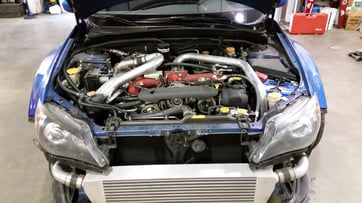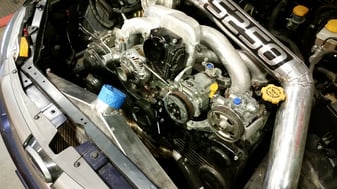If you were to look at different types of turbocharged vehicles you will find two distinct types of intercooler design. So, how do you choose which is best?
The most noticeable is the crossflow design as it often sits low in the opening of the front bumper. This style of intercooler is most often found in the import sport compact market.
The vertical flow intercooler goes un-noticed most of the time because they usually fill the entire frontal area of the car and their larger surface area is often mistaken for a traditional radiator.
These types of intercoolers are most often found on large trucks and supercharged domestics. This type of intercooler is often found in stock applications with plastic endtanks and an aluminum core. The factory Subaru Top Mount intercooler is a vertical flow design.
Crossflow intercoolers tend to have longer paths for the air to flow through. This causes some restriction to flow, but because the air spends more time in the intercooler, more heat is rejected. Sizing an intercooler is a balance between heat rejection and restriction to flow, or pressure drop. A long crossflow intercooler may have a pressure drop of 2-4 psi from the inlet to the outlet. This is resistance to flow the turbo has to overcome, making it work harder (and hotter).
 Vertical flow intercoolers have many, shorter paths for the air to flow through. Because the air paths are shorter and the air is moving so easily through the vertical flow intercooler, it doesn't reject as much heat as the crossflow, but the amount of air that can be passed through an vertical flow intercooler before resistance to flow causes a pressure drop is 3-4 times higher than a crossflow intercooler.
Vertical flow intercoolers have many, shorter paths for the air to flow through. Because the air paths are shorter and the air is moving so easily through the vertical flow intercooler, it doesn't reject as much heat as the crossflow, but the amount of air that can be passed through an vertical flow intercooler before resistance to flow causes a pressure drop is 3-4 times higher than a crossflow intercooler.
This allows the turbo and engine to breathe easier and the turbo doesn't have to work as hard to move air through the intercooler and excess heat isn't generated in the first place. Another advantadge to vertical is that the charge piping tends to be shorter.
The biggest challenge to using an vertical intercooler is packaging. This is also where having a shop that understands your application, when do you need a complex solution vs. the easiest depends on how you plan on driving your car. So, the answer is that it is up to you, get the help you need with a solid conversation.
Most cars will require a lot of custom work and fabrication services to make an vertical flow intercooler work. This is the reason the majority of aftermarket intercooler kits use a cross flow design.
Which is better? If you can fit one, a vertical flow intercooler will usually yield better results.



